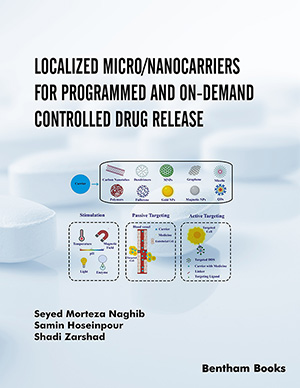Abstract
Background: Exosomes are extracellular vesicles (EVs) released from cells upon fusion of an intermediate endocytic compartment with the plasma membrane. They refer to the intraluminal vesicles released from the fusion of multivesicular bodies with the plasma membrane. The contents and number of exosomes are related to diseases such as metabolic diseases, cancer and inflammatory diseases. Exosomes have been used in neurological research as a drug delivery tool and also as biomarkers for diseases. Recently, exosomes were observed in the seminal plasma of the one who is asthenozoospermia, which can affect sperm motility and capacitation.
Objective: The main objective of this review is to deeply discuss the role of exosomes in spermatozoa after leaving the seminiferous tubule.
Methods: We conducted an extensive search of the literature available on relationships between exosomes and exosomes in spermatozoa on the bibliographic database.
Conclusion: This review thoroughly discussed the role that exosomes play in the exchange of spermatozoa after leaving the seminiferous tubule and its potential as a drug delivery tool and biomarkers for diseases as well.
Keywords: Exosomes, spermatozoa, miRNA, proteins, epididymis, prostasomes.
[http://dx.doi.org/10.1016/j.semcdb.2015.02.006] [PMID: 25704309]
[http://dx.doi.org/10.1111/cmi.12259] [PMID: 24406102]
[http://dx.doi.org/10.1016/j.tcb.2015.01.004] [PMID: 25683921]
[http://dx.doi.org/10.3390/cancers9010008] [PMID: 28085080]
[http://dx.doi.org/10.4161/cib.3.5.12339] [PMID: 21057637]
[http://dx.doi.org/10.1242/jcs.128868] [PMID: 24105262]
[http://dx.doi.org/10.1007/s00018-017-2595-9] [PMID: 28733901]
[http://dx.doi.org/10.1074/jbc.M114.588046] [PMID: 24951588]
[http://dx.doi.org/10.1242/jcs.074088] [PMID: 21242314]
[http://dx.doi.org/10.1111/j.1600-0854.2010.01041.x] [PMID: 20136776]
[http://dx.doi.org/10.1074/jbc.M109.041152] [PMID: 19801663]
[http://dx.doi.org/10.3402/jev.v3.26913] [PMID: 25536934]
[PMID: 26663221]
[http://dx.doi.org/10.1186/1471-2164-14-319] [PMID: 23663360]
[http://dx.doi.org/10.1093/nar/gku347] [PMID: 24838567]
[http://dx.doi.org/10.1083/jcb.147.3.599] [PMID: 10545503]
[http://dx.doi.org/10.3402/jev.v4.27066] [PMID: 25979354]
[http://dx.doi.org/10.1002/pmic.201200348] [PMID: 23404715]
[http://dx.doi.org/10.1126/science.1153124] [PMID: 18309083]
[http://dx.doi.org/10.1038/cr.2014.44] [PMID: 24710597]
[http://dx.doi.org/10.1371/journal.pone.0034653] [PMID: 22506041]
[http://dx.doi.org/10.1007/s00702-009-0288-8] [PMID: 19680595]
[http://dx.doi.org/10.1016/j.pharmthera.2017.02.020] [PMID: 28202367]
[http://dx.doi.org/10.1007/s12035-014-9054-5] [PMID: 25502465]
[http://dx.doi.org/10.1007/s12035-018-0912-4] [PMID: 29363042]
[http://dx.doi.org/10.1016/j.critrevonc.2015.04.002] [PMID: 25982702]
[http://dx.doi.org/10.1515/cclm-2016-0708] [PMID: 28231055]
[http://dx.doi.org/10.1095/biolreprod.105.049304] [PMID: 16510839]
[http://dx.doi.org/10.3402/jev.v4.28680] [PMID: 26563734]
[http://dx.doi.org/10.1016/j.fertnstert.2019.01.030]
[http://dx.doi.org/10.1016/j.bcmd.2005.03.005] [PMID: 15893944]
[http://dx.doi.org/10.1016/j.semcdb.2016.04.009] [PMID: 27143445]
[http://dx.doi.org/10.1530/REP-13-0058] [PMID: 23613619]
[http://dx.doi.org/10.2164/jandrol.04104] [PMID: 15955884]
[http://dx.doi.org/10.1038/gene.2015.57] [PMID: 26656449]
[http://dx.doi.org/10.1006/smim.2000.0320] [PMID: 11437632]
[http://dx.doi.org/10.1038/aja.2012.81] [PMID: 23001443]
[http://dx.doi.org/10.1093/humrep/13.suppl_1.9] [PMID: 9663766]
[http://dx.doi.org/10.1093/oxfordjournals.humrep.a137524] [PMID: 1752929]
[http://dx.doi.org/10.1016/S0015-0282(16)56768-5] [PMID: 8194629]
[http://dx.doi.org/10.3109/19396368.2012.663233] [PMID: 22788532]
[http://dx.doi.org/10.1095/biolreprod.113.110486] [PMID: 23803555]
[http://dx.doi.org/10.1111/j.1439-0272.1995.tb02087.x] [PMID: 7755184]
[http://dx.doi.org/10.1002/mrd.10136] [PMID: 12211066]
[http://dx.doi.org/10.1095/biolreprod.104.036426] [PMID: 15635128]
[http://dx.doi.org/10.1093/humrep/den181] [PMID: 18482993]
[http://dx.doi.org/10.1038/nri2567] [PMID: 19498381]
[http://dx.doi.org/10.1111/j.1365-2605.2011.01203.x] [PMID: 21875428]
[http://dx.doi.org/10.1002/mrd.20170] [PMID: 15457514]
[http://dx.doi.org/10.2164/jandrol.05108] [PMID: 16278369]
[http://dx.doi.org/10.1016/j.mce.2003.10.069] [PMID: 15109742]
[http://dx.doi.org/10.1002/(SICI)1098-2795(200005)56:1<26:AID-MRD4>3.0.CO;2-K] [PMID: 10737964]
[http://dx.doi.org/10.1093/molehr/2.1.9] [PMID: 9238651]
[http://dx.doi.org/10.1093/molehr/2.3.177] [PMID: 9238677]
[http://dx.doi.org/10.1002/(SICI)1098-2795(199710)48:2<267:AID-MRD15>3.0.CO;2-V] [PMID: 9291477]
[http://dx.doi.org/10.1080/19396368.2019.1626934] [PMID: 31204846]
[http://dx.doi.org/10.1002/(SICI)1098-2795(199705)47:1<87:AID-MRD12>3.0.CO;2-X] [PMID: 9110319]
[PMID: 11309198]
[http://dx.doi.org/10.1002/jemt.10319] [PMID: 12672125]
[http://dx.doi.org/10.1126/science.153.3731.80] [PMID: 5938421]
[http://dx.doi.org/10.1007/BF03401836] [PMID: 11474125]
[http://dx.doi.org/10.1095/biolreprod.103.019216] [PMID: 12826572]
[http://dx.doi.org/10.1093/molehr/gah075] [PMID: 15169922]
[http://dx.doi.org/10.1210/endo.137.11.8895383] [PMID: 8895383]
[http://dx.doi.org/10.1016/0014-5793(96)00120-2] [PMID: 8601455]
[http://dx.doi.org/10.1073/pnas.94.9.4782] [PMID: 9114069]
[PMID: 9310983]
[PMID: 8956364]
[http://dx.doi.org/10.1016/S0014-5793(03)00900-1] [PMID: 12965208]
[http://dx.doi.org/10.1095/biolreprod.102.013854] [PMID: 12672666]
[http://dx.doi.org/10.1095/biolreprod.105.048587] [PMID: 16436526]
[http://dx.doi.org/10.1095/biolreprod.109.078816] [PMID: 19605784]
[http://dx.doi.org/10.4103/1008-682X.155532] [PMID: 26178395]
[http://dx.doi.org/10.1042/BJ20110672] [PMID: 21689072]
[http://dx.doi.org/10.1530/REP-13-0146] [PMID: 24077955]
[http://dx.doi.org/10.1038/aja.2012.20] [PMID: 22522502]
[http://dx.doi.org/10.1371/journal.pone.0163876] [PMID: 27695046]
[http://dx.doi.org/10.1038/mt.2012.237] [PMID: 23183536]
[http://dx.doi.org/10.1101/gad.1837609] [PMID: 19933153]
[http://dx.doi.org/10.1038/cr.2012.141] [PMID: 23044802]
[http://dx.doi.org/10.1126/science.aad6780] [PMID: 26721685]
[http://dx.doi.org/10.1016/0304-4157(85)90008-5] [PMID: 2992593]
[http://dx.doi.org/10.1111/j.1439-0272.1978.tb03030.x] [PMID: 152589]
[http://dx.doi.org/10.1002/(SICI)1097-0045(20000515)43:3<169:AID-PROS2>3.0.CO;2-D] [PMID: 10797491]
[http://dx.doi.org/10.2741/4466] [PMID: 27100516]
[http://dx.doi.org/10.1530/REP-13-0358] [PMID: 24149515]
[http://dx.doi.org/10.1007/s12272-019-01167-4] [PMID: 31172440]
[http://dx.doi.org/10.1006/abbi.1998.0876] [PMID: 9784255]
[http://dx.doi.org/10.1006/abbi.1997.9999] [PMID: 9210640]
[http://dx.doi.org/10.1093/humupd/dmi052] [PMID: 16373403]
[http://dx.doi.org/10.1002/j.1939-4640.2003.tb02653.x] [PMID: 12634297]
[PMID: 31578810]
[http://dx.doi.org/10.1111/j.1768-322X.1999.tb01083.x] [PMID: 10321022]
[http://dx.doi.org/10.1002/mrd.1080420310] [PMID: 8579847]
[http://dx.doi.org/10.1054/ceca.1999.0031] [PMID: 10456226]
[http://dx.doi.org/10.1126/scisignal.2001595] [PMID: 21586728]
[http://dx.doi.org/10.1093/molehr/gav049] [PMID: 26345709]
[http://dx.doi.org/10.1042/bj2980249] [PMID: 7510950]
[http://dx.doi.org/10.1016/j.fertnstert.2007.06.056] [PMID: 17953966]
[http://dx.doi.org/10.1016/S0304-4165(97)00071-8] [PMID: 9367181]
[http://dx.doi.org/10.1016/j.fertnstert.2007.01.209] [PMID: 17562335]
[http://dx.doi.org/10.1371/journal.pone.0034566] [PMID: 22506029]
[http://dx.doi.org/10.1002/mrd.21327] [PMID: 21638509]
[http://dx.doi.org/10.1002/pros.20921] [PMID: 19143024]
[http://dx.doi.org/10.1007/978-3-319-18881-2_9] [PMID: 26178851]
[http://dx.doi.org/10.1111/j.1365-2605.2010.01116.x] [PMID: 21029115]
[http://dx.doi.org/10.3109/01485019708987900] [PMID: 9202832]
[http://dx.doi.org/10.3109/19396368.2010.549538] [PMID: 21332393]
[http://dx.doi.org/10.1016/j.bbapap.2012.08.008] [PMID: 22940639]
[http://dx.doi.org/10.1073/pnas.1018202108] [PMID: 21383182]
[http://dx.doi.org/10.1016/S0015-0282(03)02160-5] [PMID: 14607571]
[http://dx.doi.org/10.1186/1477-7827-6-5] [PMID: 18234073]
[http://dx.doi.org/10.1002/pros.10062] [PMID: 11920952]
[http://dx.doi.org/10.1530/jrf.0.0990195] [PMID: 8283438]
[http://dx.doi.org/10.1016/j.anireprosci.2014.01.007] [PMID: 24559728]
[http://dx.doi.org/10.1016/j.theriogenology.2019.08.003] [PMID: 31401476]





















